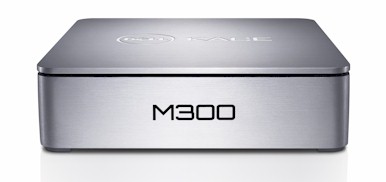Original URL: https://www.theregister.com/2011/07/14/dell_kace_m300_appliance/
Dell's Kace control freak ARMed for SMBs
Cover your assets
Posted in OSes, 14th July 2011 21:27 GMT
In February 2010, Dell shelled out an undisclosed sum for Kace Networks, a vendor of server appliances to rather big companies.
Today, the Kace systems management appliance division of Dell set its sights on much smaller businesses with an asset management appliance called the M300. The company hopes the pricey appliance will become a standard – and profitable – item among Dell's corporate PC customers.
The Kace unit is tucked underneath Dell's Consumer and SMB (CSMB) division, and at a briefing today in New York, Kace co-founder Marty Kacin said the customer base has quadrupled to more than 3,500 since the Dell acquisition.
The current crop of K1000 appliances for systems management and K2000 appliances for managing software deployment are aimed at companies with many hundreds to many thousands of PCs and servers. They have too many features and functions, run on rack servers that don't belong in the typical SMB office environment, and cost too much money.
Back to the drawing board

Kacin: Smaller customers
And so, says Kacin, Dell watched what smaller customers using the bigger Kace appliances were doing with the machines in production. It went back to the drawing board and created a set of streamlined code – including a new, simpler web interface – aimed at tackling the asset management job for machines running Windows.
The K1000 and K2000 appliances run on Dell's PowerEdge rack server platforms and are based on a hardened BSD Unix operating system, an Apache Web server, the MySQL database, and a bunch of code written in C, C++, PHP, JavaScript, and HTML.
There are virtual versions of these two appliances, encoded in a VMDK format, so they can be run on your own iron inside a VMware virtual machine was well.
The appliances support the management of Windows, MacOS, and Linux; Solaris and HP-UX were deprecated due to lack of demand.
K1000 and K2000 appliances scale from managing 1,000 to 5,000 seats and range in price from an entry $5,000 to as high as $30,000 a pop, which is not exactly in the typical SMB's budget. NASA has a bunch of the Kace appliances managing more than 100,000 devices and is Dell's largest customer for the machines.
You shouldn't need to be a rocket scientist to get some value out of a management tool, and that is what the new M300 appliance launched today (and on the cards before the Dell acquisition) aims to demonstrate.
Stripped down appliance
Rather than automating every aspect of a heterogeneous pool of machines, Dell stripped the M300 down to just supporting the Windows platforms typically found at SMBs on PCs and servers.
The M300 focuses on the perpetual and rather mundane problem of asset management – who has what PC where, what capacities and features each PC has, and what software is on it, and how do the company's software licenses (ah-hem) match up (or not) to what is on the machine.

The Kace M300 asset management appliance
The M300 appliance looks like a thin client that you might have sitting on your desk. It is based on Marvell's Armada 88F6282 ARM processor, running at 1.6GHz to 2GHz. This is aimed at routers, gateways, media servers, storage controllers, and other embedded products.
In the case of the M300 asset management appliance, Dell uses a 2GHz ARM chip and is slapping 2GB of main memory on the baby mobo, in which the Kace code can frolic.
The appliance has 16GB of solid state flash disk capacity and has room to allow for a small form factor (probably 1.8-inch, not 2.5-inch) disk drive for future models that might need to store more data. (Kacin hinted that there might be help desk and network security versions of the M300 appliance in the future.)
Don't read too much into that ARM chip choice, by the way. "We do have versions in the lab running on Atom, so don't get attached to that ARM. We could change in the future as Atom gets cooler and cheaper," says Kacin.
The M300 has no fans, which means it is not only quiet enough for an office, but for your desktop if need be. It has a single Gigabit Ethernet port and two USB ports and burns about 15 watts of juice as it is running. It comes with a 30 watt power supply.
Runs Linux, does only Windows
The M300's software stack is a little bit different from its K1000 and K2000 brethren, too. For one thing, Dell didn't just take the existing asset management features in the first two Kace appliances and snip it out, but redid the code based on what the company has learned over the years.
The code is still written in a mix of C, C++, PHP, JavaScript, and HTML, but it is different code. And instead of running on BSD and MySQL, this appliance runs the code on Linux and stores data within a PostgreSQL database.
The agent software that gets plunked on PCs and servers so they can be snooped is the same, and so is Kace's proprietary Agent Messaging Protocol. This links devices back to the appliance over the internal corporate network or through VPN running out on the Internet for portable machines. The VPN link can also be used to allow a service provider to remotely manage servers and PCs for an SMB.
The M300 appliance is restricted to monitoring no more than 200 devices. And unlike the larger Kace appliances, it cannot work with Linux or Mac OS machines. Kacin thinks there is little need to manage Linux on desktops out there among corporations.
But he says it is possible that Mac shops – or departments like graphics and design within larger companies where Macs dominate – could compel Dell to make a variant of the M300 that just handles Mac OS devices.
Counting windows
But at the moment, the M300 is restricted to spying on desktops and laptops running Windows XP Professional, Windows Vista Business, Enterprise and Ultimate, and Windows 7 Professional, Enterprise, and Ultimate. On servers, the M300 can hook into Windows Server 2003 and Windows Server 2008 (both the initial and R2 updates) in the Web, Standard, and Enterprise editions.
At $1,999 plus a mandatory one-year maintenance and support contract that costs $499, the M300 is a bit pricey for the typical SMB skinflint. But it seems reasonable that Dell will do a PC-server-M300 bundle at some point on its website, through its direct sales force, and through its channel partners.
What Dell really needs to do – and it cannot yet do according to Kacin – is ship a pallet of PCs and an M300 appliance out of the Dell factory with all of the relevant data about the PCs and their software stacks preconfigured into the M300.
The M300 can use the warranty tags on each Dell PC to get additional information about support for each device into the M300, something that cannot be done with PCs and servers from other vendors at this point.
The idea, says Kacin, is for the M300 to pay for itself by watching what software end users have installed on their machines and what software they actually use. The M300 will therefore help companies better assess what they need and pay for itself through savings in the software budget.
Moreover, because the Kace agent software constantly reports back to the management appliance, the minute end users do something that messes up their PC or a server, system admins will be able to see what they were up to in terms of adding or updating software when something went wrong, helping streamline the debugging process.
The device has been in beta with a few dozen customers and is currently only available in the United States. Dell is right now doing the assessment of what it will take in terms of language support and other internationalization features so it can be sold in the EMEA and Asia/Pacific regions. ®